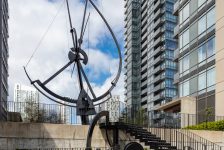Rosa Nautica is the second of three major sculptural works by Chilean artist Francisco Gazitua at CityPlace. The literal translation of Rosa Nautica is “Compass Rose” or “Windrose”, which is a nautical chart used to indicate the cardinal directions of north, south, east and west. The sculptural form of Rosa Nautica also incorporates elements of a sextant which is another type of navigation instrument used to measure the angle of the stars from the horizon. Gazitua explains that his interest in nautical themes relates to the rich maritime history of Chile, as well as his fascination with the sea as evoked in literature and poetry.

Rosa Nautica

Francisco Gazitua
b.1944
- Steel
- 2007
- 18 m x 18 m x 20 m
- 11 Brunel Court, Toronto
About the artwork
About the artist
Francisco Gazitúa was born in Santiago de Chile in 1944. He studied philosophy at the Catholic University of Chile and Sculpture at both the University of Chile, and St. Martin’s School of Arts in London. He completed his training in Chile, as a sculptor-assistant, with Lily Garafulic sculptors, Marta Colvin and Samuel Román. As well in England, with Tim Scott, Philip King and Anthony Caro. Later he was professor of sculpture, for six years at St Martins School of Arts London (1979 -1985), recognised as one of the founders of three schools of sculpture: Kornaria, Istria (Croatia), the department Sculpture at the Universidad Finis earthy (Santiago, Chile) and the Workshop School (Santiago, Chile). In Chile, he organised around fifteen international sculpture symposiums, to engage with the public at large.
He wrote numerous publications about the history and theory of sculpture. His theoretical and practical discussions focus on the role of materiality in the sculptural language.
The main objective of his sculptural practice is the production of large-scale works for public spaces. Working with materials such as steel, wood and stone, he has built a large workshop located at the foot of the Andes in central Chile where, along with his assistants, he builds and assembles the work. His last monumental public sculpture is set in Toronto, Puente de luz (“Bridge of light”), a 100 meter long steel structure, now a major landmark for the city.
His work was exhibited in solo and group exhibitions in major galleries and museums in Chile, Canada, England, Germany, USA, Mexico, and many other countries.
Fun facts
- When approaching the giant steel structure, passersby are invited to take staircases, remembering the artist of lifting bridges in castles.
Engagement questions
- What symbols do you notice in the artwork?
- If this artwork was untitled, what title would you give to it and why?
- How do the different elements in this work contribute to a central theme or idea?
